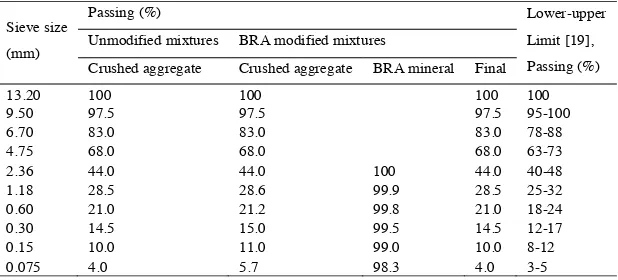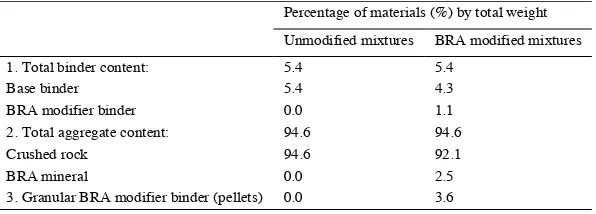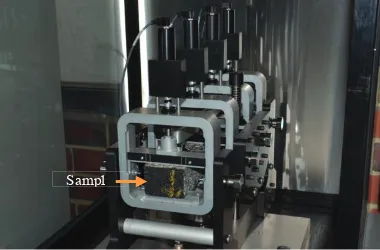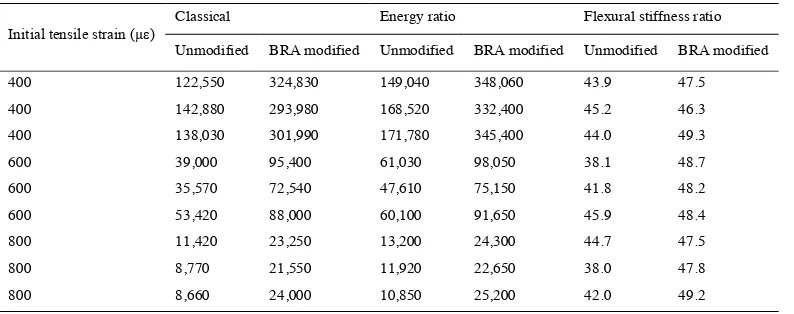Procedia Engineering 125 ( 2015 ) 452 – 460
1877-7058 © 2015 The Authors. Published by Elsevier Ltd. This is an open access article under the CC BY-NC-ND license (http://creativecommons.org/licenses/by-nc-nd/4.0/).
Peer-review under responsibility of organizing committee of The 5th International Conference of Euro Asia Civil Engineering Forum (EACEF-5) doi: 10.1016/j.proeng.2015.11.120
ScienceDirect
The 5th International Conference of Euro Asia Civil Engineering Forum (EACEF-5)
Using advanced materials of granular BRA modifier binder to
improve the flexural fatigue performance of asphalt mixtures
Muhammad Karami
a,*, Hamid Nikraz
aaDepartment of Civil Engineering, Curtin University, GPO Box U1987, Perth, WA 6845, Australia
Abstract
The objective of this research is to determine the effect on the flexural fatigue performance of asphalt mixtures of using granular Buton rock asphalt (BRA) modifier binder. A repeated flexural bending test under the controlled-strain mode of loading in accordance with Austroads AG:PT/T233 test method was conducted to examine fatigue behaviour of the BRA modified asphalt mixtures and the unmodified asphalt mixtures (as control mixtures) for a dense grading of 10 mm. Beam specimens were tested at the temperatures of 20°C and three different peak tensile strain (400, 600 and 800 με) and used classical and energy-stiffness ratio approach to analyse fatigue life of the asphalt mixtures. According to the test results, the fatigue lifes of the BRA modified asphalt mixtures were higher than that for the unmodified asphalt mixtures at the test temperature and tensile strain. Moreover, based on the initial flexure stiffness and phase angle values, BRA modified asphalt mixtures showed more elastic and less viscous behaviour than unmodified mixtures.
© 2015 The Authors. Published by Elsevier Ltd.
Peer-review under responsibility of organizing committee of The 5th International Conference of Euro Asia Civil Engineering Forum (EACEF-5).
Keywords: Granular BRA modified; asphalt mixtures; flexural fatigue performance.
1.Introduction
The fatigue resistance of asphalt mixes is defined as the capability of the mixes to withstand the repetitive loading without any significant failure such as cracking or premature failure, developed under other circumstances such as environmental conditions. According to studies, fatigue cracking is a result in fatigue failure due to repetitive stress and strains caused by load and environmental factors which is considered as a major distress happening in asphalt
* Corresponding author. Tel.: +61 0451181972
E-mail address: [email protected] .edu.au; [email protected]
© 2015 The Authors. Published by Elsevier Ltd. This is an open access article under the CC BY-NC-ND license (http://creativecommons.org/licenses/by-nc-nd/4.0/).
mixtures [1-3]. The cracking is initially started from micro-crack and it then grows to form macro-crack and finally penetrate the surface of pavement [4].
According to Baburamani, generally, the factors influencing the fatigue cracking can be categorized as follows: loading variables (such as traffic speed, rest period, axle loads and axle distribution), environmental factors (such as temperature and ageing), construction variables, and materials characteristics [5]. Vazquez et al. stated that the most factors affecting the resistance to fatigue cracking of asphalt mixtures are asphalt binder grade, asphalt binder content, and air void content. Hence the adequate binder content and density should be used in asphalt mixtures to increase the resistance to fatigue cracking [6]. In addition, according to Guler [7] and Khiavi [1], binder type is considered as an important factor among the others such as aggregate gradation, aggregate type, binder content, compaction temperature, and traffic loading that can give a significant effect to fatigue life of the bituminous mixes.
The use and development of modified binders in asphalt mixes is important with the aim of increasing the fatigue performance. Many studies have carried out on asphalt mixtures to improve the resistance to fatigue failure. Polymer modified binder have been found to improve several properties of asphalt mixtures such as fatigue life [8-10]. Sibal et al. reported that the addition of crumb rubber obtained from waste tires in the form of fine aggregates increased the fatigue life of asphalt mixes [11].
This research considered the use of granular Buton rock asphalt (BRA) modifier binder as advanced materials with the aim to improve the fatigue performance of bituminous mixtures. The raw materials of granular BRA modifier binder are found in the island of Buton in Indonesia that is traditionally known as Asphalt Buton (Asbuton). A few researches have been done on the asphalt mixtures modified with Asbuton or Asbuton products. Zamhari et al. [12] conducted the laboratory research on asphalt mixtures using raw materials of Asbuton and found that the addition of Asbuton in a certain amount increased the stiffness modulus values and rutting performance. Affandi [13] reported that the stiffness modulus is increased and the temperature sensitivity of asphalt mixtures is improved by using BRA modifier binder semi-extraction. Other Asbuton products, for example, filler, were studied and resulted in an increase in the resilient modulus and rutting potential [14], and also in the fatigue performance of asphalt mixtures [15]. With the processing technologies have been developing in recent times, the granular BRA modifier binder are now produced. The developments have aimed to enhance the characteristics of granular BRA modifier binder to meet the requirements for use in asphalt mixtures, such as increased fatigue life. However, there is a lack of research conducted to develop the use of material derived from Buton Rock Asphalt on asphalt mixtures, especially in term of using granular BRA in asphalt mixtures. Hence, the main purpose of this study is to compare the fatigue performance for the unmodified and BRA modified asphalt mixtures, focused on analyzing by using the phenomenological and energy stiffness ratio approach.
2.Materials and methods
2.1.Asphalt binder
This research used a type of asphalt cement, C170, as the base asphalt binder, for unmodified asphalt mixtures. This binder is classified according to the Australian Standard AS 2008 [16]. Some properties of the base binder are shown in Table 1. In this study, BRA modified binder used for BRA modified asphalt mixtures consist of replacing 20% of the base asphalt binder (by total weight of asphalt binder in the mixtures) with 20% of the BRA natural binder, with the purposes of improving the resistance of BRA modified asphalt mixture to fatigue.
Table 1. Properties of bitumen C-170.
Properties Test Method Value Properties Test Method Value
Density, Kg/L ASTM D-1298 1.03 Viscosity at 60ºC, Pa.S ASTM D-445 170
Flash point, ºC ASTM D-93 >250 Viscosity at 135ºC, Pa.S ASTM D-445 0.35
Fig. 1. The form of granular BRA modifier binder (pellets).
2.2.Aggregates
A crushed granite aggregate from a local quarry in Western Australia was used in all of mixtures. The coarse and fine aggregates required to prepare the mixes were obtained by sieving on each sieve diameter. One dense graded used for unmodified and BRA modified asphalt mixtures with maximum aggregate size of 9.5 mm were based on Specification 504 [19] used in Western Australia. Regarding the mineral content in the granular BRA modifier binder, in this study, the aggregate gradation of crushed aggregate for BRA modified asphalt below 2.36 was adjusted to accommodate the mineral content in the granular BRA modifier binder as shown in Table 2. Therefore, it was necessary that the weight of the crushed aggregate was reduced by the BRA mineral in order to minimize the variance of aggregate gradation. Thus, it was considered that the aggregate gradations of the unmodified asphalt mixtures and the final gradation of the BRA modified asphalt mixtures was the same as a constant parameter.
Table 2. Aggregate gradation used in this study.
Sieve size
(mm)
Passing (%) Lower-upper
Limit [19],
Passing (%) Unmodified mixtures BRA modified mixtures
Crushed aggregate Crushed aggregate BRA mineral Final
13.20 100 100 100 100
9.50 97.5 97.5 97.5 95-100
6.70 83.0 83.0 83.0 78-88
4.75 68.0 68.0 68.0 63-73
2.36 44.0 44.0 100 44.0 40-48
1.18 28.5 28.6 99.9 28.5 25-32
0.60 21.0 21.2 99.8 21.0 18-24
0.30 14.5 15.0 99.5 14.5 12-17
0.15 10.0 11.0 99.0 10.0 8-12
0.075 4.0 5.7 98.3 4.0 3-5
2.3.Mix design and specimen preparation
optimum binder content (OBC) was determined as 5.4% by the weight of the mixture. In this study, the same binder content was used for the BRA modified asphalt mixtures and the unmodified asphalt mixtures in order to maintain consistency for comparison purposes (Table 3).
After the OBCs were determined, the BRA modified asphalt mixtures were manufactured as follows: First, dried hydrated lime was included in the blended aggregates in the form of anti-strip additives at a dose of 1.5% by weight of total aggregates in accordance with Specification 504 [19]. The blended aggregates were heated in a controlled temperature oven at 105ºC for at least 24 hours. Base asphalt binder and specific percentages of granular BRA modifiers binder (pellets) (Table 3) were put in a bowl together and then heated in another oven at 150±5ºC for 30 min to one hour with frequent manual stirring in order to blend and incorporate the two binders. Then the previously blended aggregates were put in the same bowl and mixed with the BRA modified asphalt binder using mixer equipment for 1.5 minutes. Laboratory mixtures were prepared based on the procedure for sampling loose asphalt described in Standard AS 2891.1.1-2008 [20], and then were immediately compacted in a slab mold by using a roller compactor in accordance with Austroads AG:PT/T220 [21]. After 24 hours prior to compaction process, slabs size of 400 mm in length, 400 mm in width and 100 mm in height, were then cut to produce the final beam specimens with dimensions 390±5 mm in height, 50±5 mm in depth and 63.5±5 mm in width.
Table 3. The composition of materials in asphalt mixtures.
Percentage of materials (%) by total weight
Unmodified mixtures BRA modified mixtures
1. Total binder content: 5.4 5.4
Base binder 5.4 4.3
BRA modifier binder 0.0 1.1
2. Total aggregate content: 94.6 94.6
Crushed rock 94.6 92.1
BRA mineral 0.0 2.5
3. Granular BRA modifier binder (pellets) 0.0 3.6
2.4.Repeated flexural bending test
Fatigue performance of unmodified and BRA modified asphalt mixtures in this study were performed using repeated flexural bending test under the controlled-strain mode of loading in accordance with Austroads AG:PT/T233 [22]. According to this test method, beam specimens were tested under the test conditions are as follows: test temperature of 20 ºC, loading frequency of 10 Hz, mode of loading is continuous haversine, peak tensile strain is 400, 600, and 800 με, and air void content is 5%.
Before each testing was started, the specimen was placed inside the device cabinet for two hours to ensure that the temperature recorded during the test was the temperature of the test specimen and to maintain the temperature during the test. Then, the specimen was positioned in the loading frame cradle and clamped at the four points to hold the specimen in place as seen in Fig. 2. After clamped and before the test was run, the specimen was allowed a minimum of 30 minutes to enable the specimen clamping stress to be relieved. Initially, the test specimens were conditioned through the application of 50 load cycles and then the calculation of the initial flexural stiffness was at the 50th load
cycles.
3.Results and discussion
the real condition of pavement [1,26]. However, to find out the fatigue life of unmodified and BRA modified asphalt mixtures, this study used classical and energy ratio concepts, and control strain mode during the test.
Fig. 2. The set-up of the repeated flexural bending test.
3.1.Initial flexural stiffness and phase angle
Table 4 summarizes the statistics analysis for air void content, initial flexural stiffness and phase angle, of unmodified and BRA modified asphalt mixtures. A paired sample t-test method with 95% level of confidence was used to statistically analyze using IBM SPSS statistic 21 program. Table 5 shows the mean, standard deviation (S), and coefficient of variation (CV) of void contents, initial flexural stiffness and phase angle for both unmodified and BRA modified asphalt mixtures. The CV values of both mixtures are maximum 10%. These same values of the initial flexural stiffness and phase angle are illustrated in Fig. 3.
As presented in Table 4, the difference in the initial tensile strain did not affect significantly the initial flexural stiffness values for both unmodified and BRA modified asphalt mixtures. However, comparison of unmodified and BRA modified flexural stiffness in the same strain level, indicates that the initial flexural stiffness of BRA modified mixtures was statistically significantly higher than for unmodified mixtures. The initial flexural stiffness for BRA
modified asphalt mixtures at 400, 600, and 800 με was 71, 61, and 67%, respectively, higher than for unmodified
asphalt mixtures as seen in Fig. 3, and that the behavior of the BRA modified mixtures at a given initial tensile strain and measured at loading frequency of 10 Hz was more elastic.
The density of asphalt mixtures was related to fatigue cracking potential [28]. Baburamani [5] stated that compaction level (air voids) achieved in the mix affect the flexural stiffness and fatigue life of the asphalt mixtures. Hence, the beam fatigue samples in this study were provided with statistically the same density (air voids) with the aim to limit the effect of density on flexural stiffness as seen in Table 4.
Table 4. A paired sample t-test results of air voids, initial flexural stiffness, and phase angle.
Asphalt mixtures Initial tensile strain (με)
Air void Initial flexural stiffness Phase angle
t df Sig. (2-t) d t df Sig. (2-t) d t df Sig. (2-t) d
Unmodified 400 – 600 1.7 2 0.225 1.75 -0.3 2 0.779 -0.18 -0.196 2 0.862 -0.19
400 – 800 0.5 2 0.667 0.49 -2.6 2 0.118 -1.53 -0.206 2 0.856 -0.21
600 – 800 -0.8 2 0.529 -0.75 -0.8 2 0.484 0.49 0.813 2 0.502 0.47
BRA modified 400 – 600 -2.0 2 0.184 -2.03 0.2 2 0.831 0.14 -4.223 2 0.052 -4.22
400 – 800 -2.0 2 0.184 -2.03 -2.8 2 0.106 -1.63 -1.623 2 0.246 -1.62
600 – 800 0.0 2 1.000 0.00 2.3 2 0.151 1.31 1.623 2 0.246 1.62
Unmodified-
BRA modified
400 3.4 2 0.074 3.46 -8.8 2 0.013 -5.09 14.321 2 0.005 14.33
600 1.0 2 0.423 1.00 -16.3 2 0.004 -9.42 5.657 2 0.030 5.66
800 1.7 2 0.225 1.73 -16.6 2 0.004 -9.58 8.738 2 0.013 8.73
Fig. 3 also shows the phase angle of unmodified and BRA modified in a given initial tensile strain. The phase angle for the two asphalt mixtures did not indicate sensitivity to initial tensile strain, while the phase angle values for the unmodified mixtures are significantly higher than the values obtained for the BRA modified mixtures for a given initial tensile strain (Table 4), which means the BRA modified mixtures show less viscous behavior than the unmodified mixtures.
Table 5. Air void, initial flexural stiffness and phase angle of asphalt mixtures.
Asphalt mixtures Initial tensile
strain (με)
Air void (%) Initial flexural stiffness (MPa) Phase angle (degree)
Mean S CV Mean S CV Mean S CV
Fig. 3. The initial flexural stiffness values for unmodified and BRA modified asphalt mixtures.
3.2.Fatigue life
The results of the flexure fatigue tests obtained in this study were analyzed using the classical approach and energy stiffness ratio method developed by Abojaradeh [29]. In classical method, failure point is assumed as the number of loading corresponding to the 50% reduction of initial flexural stiffness. Furthermore, the energy stiffness ratio method defines energy stiffness ratio as the ratio of the flexure stiffness at cycle-i (Si) to the initial flexure stiffness (So)
multiplied by the load cycle value at cycle-i (Ni) as shown by Equation 1. Fatigue failure is defined as the number of
cycles where the energy stiffness ratio produces a peak value, by plotting the energy stiffness ratio versus the number of load cycles. The results of the fatigue lives using both approaches are summarized in Table 6. It can be seen that the BRA modified asphalt mixtures shows 1.5 – 2.7 times higher fatigue lives when compared to unmodified asphalt mixtures. The flexural stiffness ratio values (SNf/S0) obtained by using energy-stiffness ratio method were 38.0-45.9
for unmodified asphalt mixtures and 46.3-49.3 for BRA modified asphalt mixtures.
Table 6. Fatigue life of unmodified and BRA modified asphalt mixtures (cycles).
Initial tensile strain (με) Classical Energy ratio Flexural stiffness ratio
Unmodified BRA modified Unmodified BRA modified Unmodified BRA modified
400 122,550 324,830 149,040 348,060 43.9 47.5
400 142,880 293,980 168,520 332,400 45.2 46.3
400 138,030 301,990 171,780 345,400 44.0 49.3
600 39,000 95,400 61,030 98,050 38.1 48.7
600 35,570 72,540 47,610 75,150 41.8 48.2
600 53,420 88,000 60,100 91,650 45.9 48.4
800 11,420 23,250 13,200 24,300 44.7 47.5
800 8,770 21,550 11,920 22,650 38.0 47.8
800 8,660 24,000 10,850 25,200 42.0 49.2
3.3.Fatigue life prediction
In this study, the strain approach and strain-mix stiffness approach are used to predict the fatigue life of unmodified and BRA modified asphalt mixtures. A simple form of strain approach model was established for control strain test using the linier regression analysis between fatigue life logarithm (log Nf) and the initial strain logarithm (log εt). The
strain approach model can be represented as Equation 2 [8,30-32]. Furthermore, as cited in Baburamani, asphalt mixtures stiffness strongly influenced the critical horizontal strain or stress due to traffic load in the asphalt layer. The incorporating of applied strain and the stiffness in the mix were expressed as Equation 3 [5].
ܰൌ ܽ ൬ߝͳ ௧൰
ሺʹሻ
where Nf is number of repetition to failure, a and b are regression coefficients, and εt is initial tensile strain applied.
ܰൌ ܣ ൬ߝͳ ௧൰
൬ܵͳ
௫൰
ሺ͵ሻ
where Nf is number of cycles to failure, εt is the tensile strain, Smix is the initial asphalt mix stiffness, and A, b, and c are regression constant.
Fig. 4. Fatigue characteristics of unmodified and BRA modified asphalt mixtures.
Table 7. Regression equation developed for unmodified and BRA modified asphalt mixtures
Classical Energy ratio
Asphalt mixtures
Strain method Strain-stiffness method Strain method Strain-stiffness method
It is important to note that the bitumen type used in the asphalt mixtures has an important influence on the fatigue life of the asphalt mixtures. Results from this study showed that the granular BRA modifier binder was beneficial in term of improved fatigue lives of asphalt mixtures. Results also indicated that BRA modified asphalt mixtures showed more elastic and less viscous behavior. In addition, using two methods, strain and strain-stiffness methods, it was found that the initial flexural stiffness influenced the longer fatigue lives of asphalt mixtures.
Acknowledgements
The first author is grateful for the support from the Directorate of Higher Education (DIKTI) – Indonesian Ministry of Education within the scholarship program, and for the support received in undertaking this research from the University of Lampung, Indonesia.
References
[1] A. K. Khiavi and M. Ameri, "Laboratory evaluation of strain controlled fatigue criteria in hot mix asphalt," Construction and Building Materials, vol. 47, pp. 1497-1502, 2013.
[2] H. Hakimelahi, S. Saadeh, and J. Harvey, "Investigation of fracture properties of California asphalt mixtures using semicircular bending and beam fatigue tests," Road Materials and Pavement Design, vol. 14, pp. 252-265, 2013.
[3] Q. Li, H. J. Lee, and T. W. Kim, "A simple fatigue performance model of asphalt mixtures based on fracture energy," Construction and Building Materials, vol. 27, pp. 605-611, 2012.
[4] F. Zhou, X. Hu, S. Hu, L.F. Walubita, and T.Scullion, "Incorporation of Crack Propagation in the M-E Fatigue Cracking Prediction," Road Materials and Pavement Design, vol. 9, pp. 433-465, 2008.
[5] P. Baburamani, "Asphalt fatigue life prediction model - a literature review," Victoria - Australia1999.
[6] C. G. Vazquez, J.P. Aguiar-Moya, A. de F. Smit, and J.A. Prozzi, "Laboratory Evaluation of Influence of Operational Tolerance (Acceptance Criterion) on Performance of Hot-Mix Asphalt Concrete," Center for Transportation Research The University of Texas, USA, Austin, USA2010.
[8] S. S. Awanti, M. S. Amarnath, and A. Veeraragavan, "Influence of rest periods on fatigue characteristics of SBS polymer modified bituminous concrete mixtures," International Journal of Pavement Engineering, vol. 8, pp. 177-186, 2007.
[9] C. Brovelli, M. Crispino, J. Pais, and P. Pereira, "Using polymers to improve the rutting resistance of asphalt concrete," Construction and Building Materials, vol. 77, pp. 117-123, 2015.
[10] T. W. Kim, J. Baek, H.J. Lee, and J.Y. Choi, "Fatigue performance evaluation of SBS modified mastic asphalt mixtures," Construction and Building Materials, vol. 48, pp. 908-916, 2013.
[11] A. Sibal, A. Das, and B. B. Pandey, "Flexural Fatigue Characteristics of Asphalt Concrete with Crumb Rubber," International Journal of Pavement Engineering, vol. 1, pp. 119-132, 2000.
[12] K. A. Zamhari, M. Merhadi, and M.H. Ali, "Comparing the Performance of Granular and Extracted Binder from Buton Rock Asphalt," International Journal Pavement Research Technology vol. 7, pp. 25-30, 2014.
[13] F. Affandy, "The performance of bituminous mixes using Indonesia natural asphalt," presented at the 25th ARRB Conference, Perth, Western Australia, 2012.
[14] B. S. Subagio, B. Siswosoebrotho, and R. Karsaman, "Development of laboratory performance of indonesia rock asphalt (ASBUTON) in hot rolled asphalt mix," in Proceeding of the Eastern Asia Society for Transportation Studies, 2003, pp. 436-449.
[15] B. S. Subagio, J. Adwang, R.H. Karsaman, and I. Fahmi, "Fatigue performance of HRA (hot rolled asphalt) and superpave mixes using Indonesian rock asphalt (asbuton) as fine aggregates and filler," Journal of the Eastern Asia Society for Transportation Studies vol. 6, pp. 1207-1216, 2005.
[16] Australian Standard, "Residual bitumen for pavements," in AS 2008-1997, ed. New South Wales, Australia, 1997.
[17] Main Roads Western Australia, "Bitumen content and particle size distribution of asphalt and stabilised soil: centrifuge method," in Test method WA 730.1-2011, ed. Perth, 2011, pp. 1-4.
[18] H. Silva, J. Pais, P. Pereira, and L. Picardo-Santos "Evaluation of the bond between mastic and coarse aggregates," 3rd International Symposium on Maintenance and Rehabilitation of Pavement and Technological Control, pp. 465–474, 2003.
[19] Main Road Western Australia, "Asphalt Wearing Course," in Specification 504, ed. Perth, 2010, pp. 1-45.
[20] Australian Standard, "Methods of sampling and testing asphalt - Method 1.1: Sampling loose asphalt," in AS 2891.1.1-2008, ed. New South Wales, Australia, 2008, pp. 1-12.
[21] Austroads, "Sample preparation - compaction of asphalt slabs suitable for characterisation," in AG:PT/T220, ed. Sydney, New South Wales 2005, pp. 1-11.
[22] Austroads, "Fatigue life of compacted bituminous mixes subject to repeated flexural bending," in AG:PT/T233, ed. Sydney, New South Wales, 2006, pp. 1-17.
[23] G. Al-Khateeb, and A. Shenoy, "A distinctive fatigue failure criterion," Association of Asphalt Paving Technology, vol. 73, pp. 585-622, 2004.
[24] S. Shen, and S.H. Carpenter, "Dissipated energy concepts for HMA performance: fatigue and healing," Departmen of Civil and Environmental Engineering - University of Illinois, Urbana, Illinois - USA2007.
[25] F. Pérez-Jiménez, R. Miró, A. Martínez, R. Botella, O. Reyes, G. Valdés, "False Failure in Flexural Fatigue Tests," 2nd Workshop on Four Point Bending, Pais (ed.), University of Minho, 2009.
[26] G. Dondi, M. Pettinari, C. Sangiorgi, and S.E. Zoorob, "Traditional and Dissipated Energy approaches to compare the 2PB and 4PB flexural methodologies on a Warm Mix Asphalt," Construction and Building Materials, vol. 47, pp. 833-839, 2013.
[27] M. M. Yuan, Z.X. Ning, C.W. Qiang, and Z.S. Xian, "Ratio of Dissipated Energy Change-based Failure Criteria of Asphalt Mixtures," Research Journal of Applied Sciences, Engineering and Technology, vol. 6, pp. 514-2519, 2013.
[28] W. S. Mogawer, A.J. Austerman, J.S. Daniel, F. Zhou, and T. Bennert, "Evaluation of the effects of hot mix asphalt density on mixture fatigue performance, rutting performance and MEPDG distress predictions," International Journal of Pavement Engineering, vol. 12, pp. 161-175, 2011.
[29] M. Abojaradeh, "Development of Fatigue Failure Criterion for Hot-Mix Asphalt Based on Dissipated Energy and Stiffness Ratio," Jordan Journal of Civil Engineering, vol. 7, 2013.
[30] P. K. Shukla and A. Das, "A re-visit to the development of fatigue and rutting equations used for asphalt pavement design," International Journal of Pavement Engineering, vol. 9, pp. 355-364, 2008.
[31] N. Li, A.A.A Molenaar, M.F.C. van de Ven, and S. Wu, "Characterization of fatigue performance of asphalt mixture using a new fatigue analysis approach," Construction and Building Materials, vol. 45, pp. 45-52, 2013.





